A Study of Chinese Ceramics in the Cirebon Wreck
In 2003, local fishermen discovered Chinese ceramics in
their fishing nets in the Java Sea, recovered from a
shipwreck located approximately 54 meters deep and 100
kilometers off the coast of Cirebon, West Java. A
private company salvaged the wreck in 2004, recovering
around 250,000 artifacts:
-
65%: Chinese and other ceramics.
-
10%: Near Eastern and Indian glassware and gemstones.
-
Remainder: Ingots and metal implements.
The ship, identified as Indonesian-made, was likely
engaged in intra-regional trade. Scholars believe it
loaded its cargo at a Srivijaya-controlled port before
setting sail for Central or East Java. The vessel’s
substantial cargo volume suggests a thriving consumer
market in Java. Given the political dynamics of the era,
the ship was probably bound for East Java. Between the
8th and 10th centuries, the Mataram Kingdom, a
Hindu-Buddhist state in Central Java, rivaled the
Srivijaya Empire, the dominant maritime power based in
Palembang. While Mataram’s agrarian economy did not
directly challenge Srivijaya’s control over trade, by
the early 10th century, Java’s economic and demographic
center had shifted eastward to the Brantas Delta (near
modern-day Surabaya). This region developed a mixed
economy, integrating agriculture with maritime commerce.
Inscriptions from the 10th–13th centuries attest to
bustling trade networks at East Javanese ports such as
Tuban and Gresik in the Brantas Delta, alongside Jepara
on Central Java’s northern coast.
 |
| Location of Cirebon Wreck |
Dating of the Chinese Ceramics and the Wreck
Key evidence suggests the wreck dates to the late 10th century:
- Lead Coins: Inscribed with "Qian Heng Zhong Bao" (乾亨重宝), first minted in 917 A.D. by the Nanhan Kingdom (Five Dynasties period).
- Yue Bowl Inscription: A cyclical date "wu chen" (戊辰) and the workshop mark "Xu Ji Shao" (徐记烧). Stylistic analysis confirms a production date of 968 A.D.
- Historical Context: The wreck likely occurred within five years of 968 A.D., during the Five Dynasties–Northern Song transition. Nanhan and Wuyue (producers of Yue ware) were absorbed into the Song Empire by 971 and 978 A.D., respectively.
|
|
| Yue bowl with inccised Wu Chen Xu Ji Shao Mark |
Analysis of the Chinese Ceramics in the Cargo
The recovered ceramics were predominantly Yue greenware, with smaller quantities of whitewares and Guangdong greenware jars and basins.
Notably absent were Changsha painted ceramics—a
prominent commodity in Tang dynasty trade and found in
9th-century shipwrecks such as the Belitung
(Indonesia), Chau Tan and Ba Ria
(Vietnam) sites. This absence suggests
that by the early 10th century, Changsha wares no longer
played a significant role in Chinese maritime trade,
aligning with archaeological evidence dating their
terminal production to the Five Dynasties Period.
Yue kilns had solidified their dominance in greenware production by this time, a status maintained into the early Northern Song period. Yue ware catered to both high-end and lower-end overseas markets, demonstrating broad commercial appeal.
Meanwhile, Xing whiteware from Hebei faced mounting competition from emerging northern kilns producing similar ceramics. By the Five Dynasties Period, its prominence had waned, and its position as the preeminent center for whiteware production was ultimately supplanted by Ding ware.
Since the Tang Dynasty, Guangdong kilns in the Pearl River Delta was the main supplier of green glazed storage jars and basins. It has maintained its position in this category without challenge.
1. Yue Greenware
Historical Background
The Yue kilns of Zhejiang had a long tradition of greenware production, dating back to the Zhou period (1046–256 BCE). Potters refined celadon during the Eastern Han (25–220 CE), and by the Tang dynasty (618–907 CE), Yue ware became highly valued, especially in tea culture. The finest examples were Mise porcelain, praised in 9th-century texts.
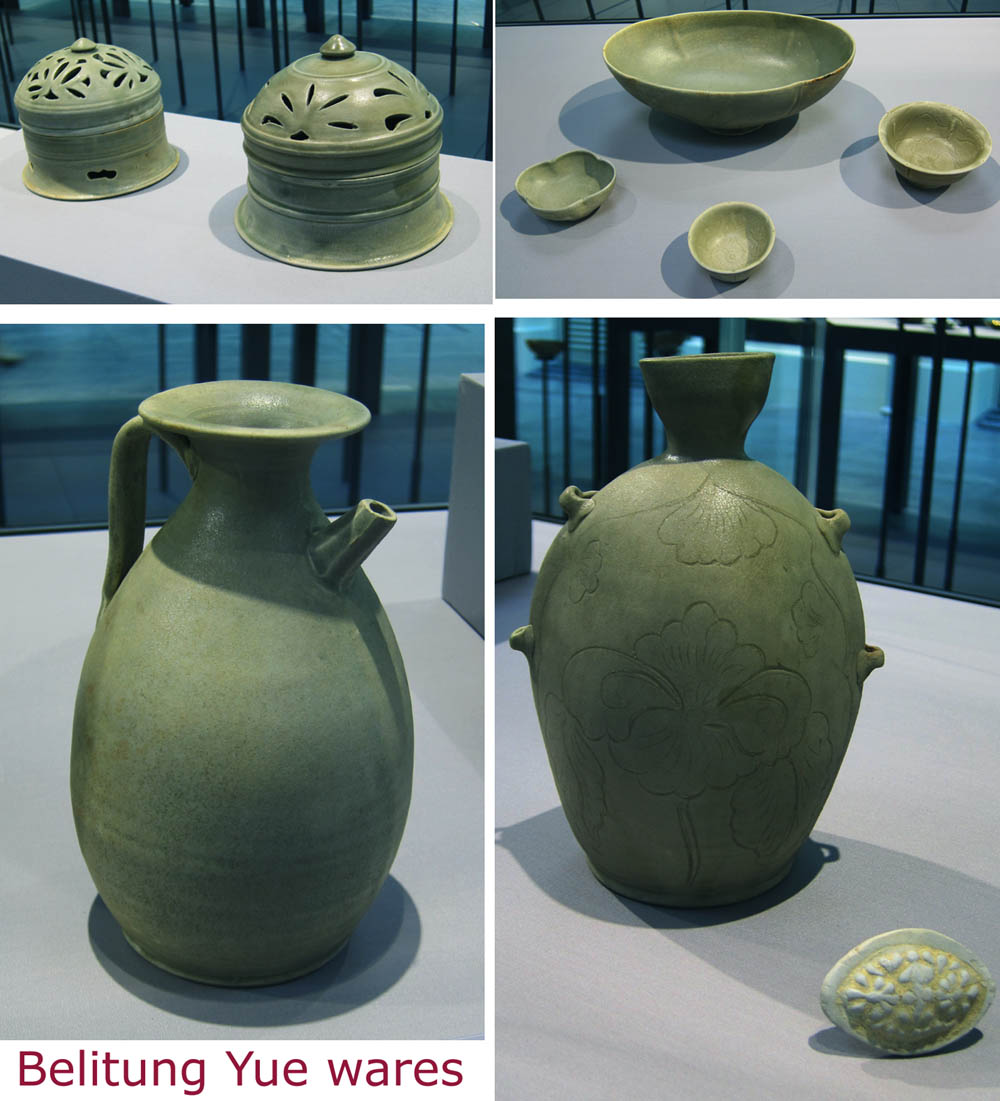 |
| Belitung Yue wares exhibited in Singapore Asian Civilisation Museum. |
Yue ware peaked during the Five Dynasties and Northern Song (907–1127 CE) but declined afterward. The Wuyue Kingdom (907–978 CE) supported its production, leading to large-scale tribute wares and exports, with many pieces found in Southeast Asia, including the Cirebon shipwreck. Major production centers were around Shanglin Lake and Dongqian Lake, with over 80 kiln sites identified. Mingzhou (modern Ningbo) served as the primary export hub, connecting Yue ceramics to trade networks across Asia and the Indian Ocean.
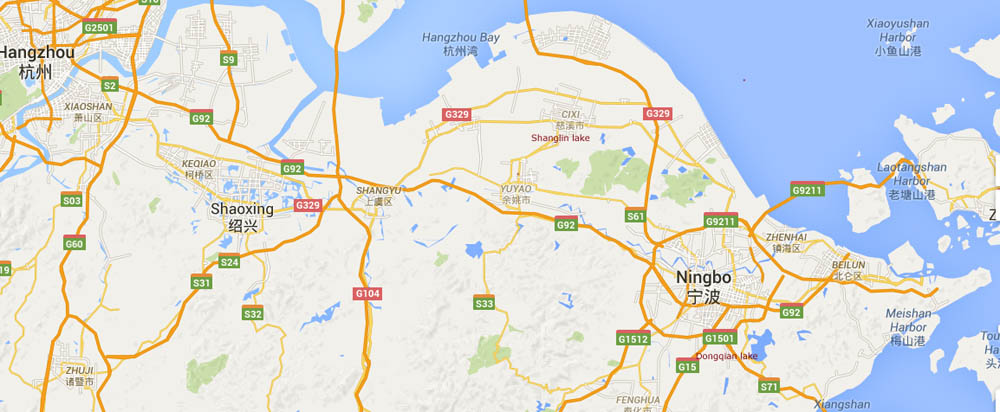 |
 |
| Map showing distribution of Yue kilns |
The Cirebon Cargo: A Treasure of Yue Wares
The Cirebon shipwreck cargo offers a remarkable
assemblage of Yue ceramics, highlighting the diversity
of vessel forms and decorative motifs characteristic of
the transitional Five DynastiesNorthernSong period.
Vessel Types and Decoration
- Bowls and Dishes
Bowls and dishes dominated the cargo, primarily
comprising modest-quality wares produced for mass
consumption. These utilitarian pieces often retain
interior marks from kiln-stacking clay supports (clay
lumps or strips) and feature unglazed foot rings,
reflecting efficient kiln-packing practices.



In contrast, higher-quality bowls and dishes exhibit
fully glazed foot rings and lack interior stacking marks,
suggesting they were fired individually in *saggars*
(protective ceramic containers). While most retain
simple forms, finer examples display lobed rims, fluted
walls, and splayed feet—designs influenced by
contemporary silverware. The most distinctive decorative
element is the carved lotus petal motif in high relief
on exterior walls, a hallmark of Five Dynasties and Song
ceramics. The finest pieces are further embellished with
intricately incised patterns.
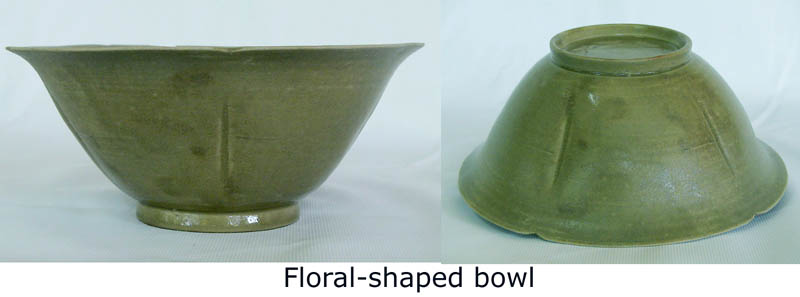
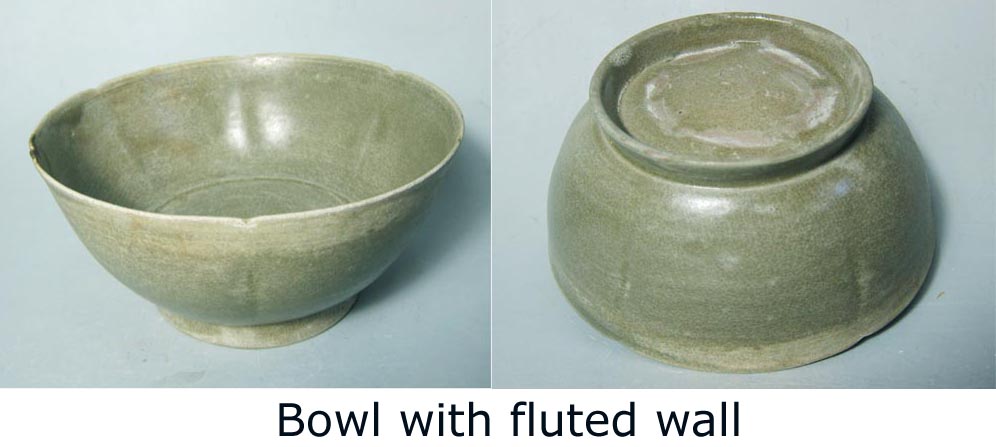
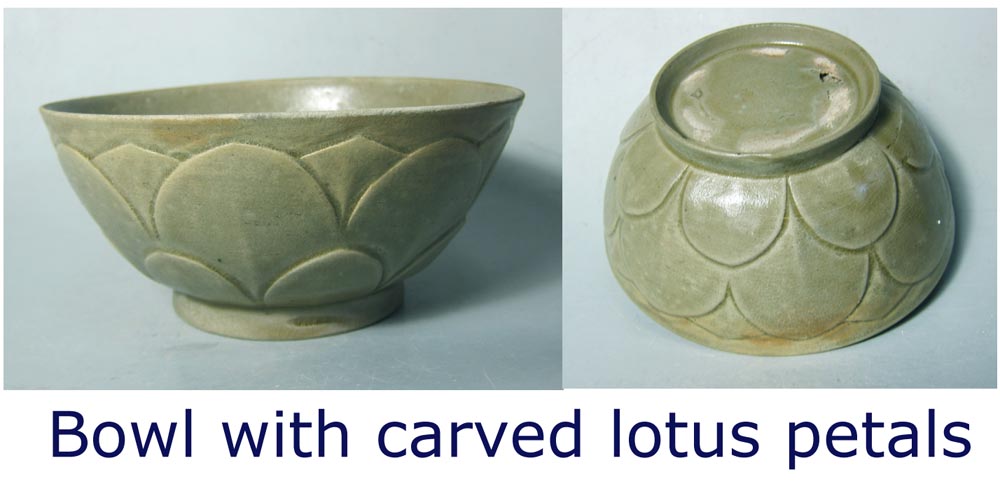

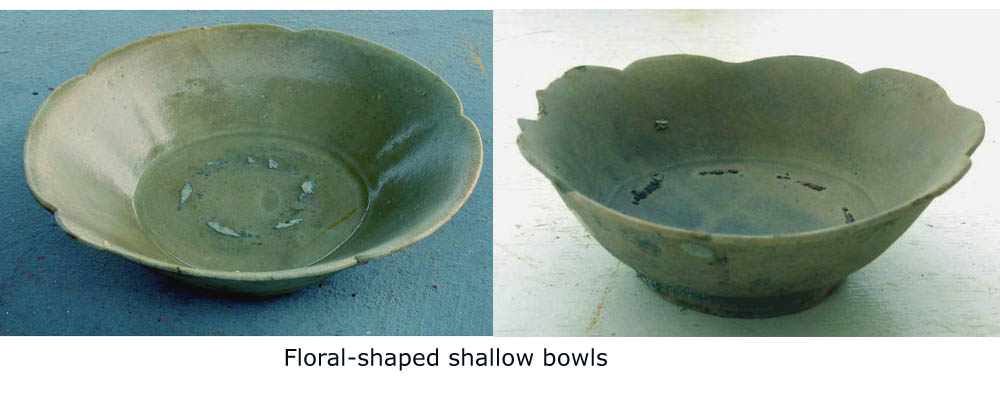

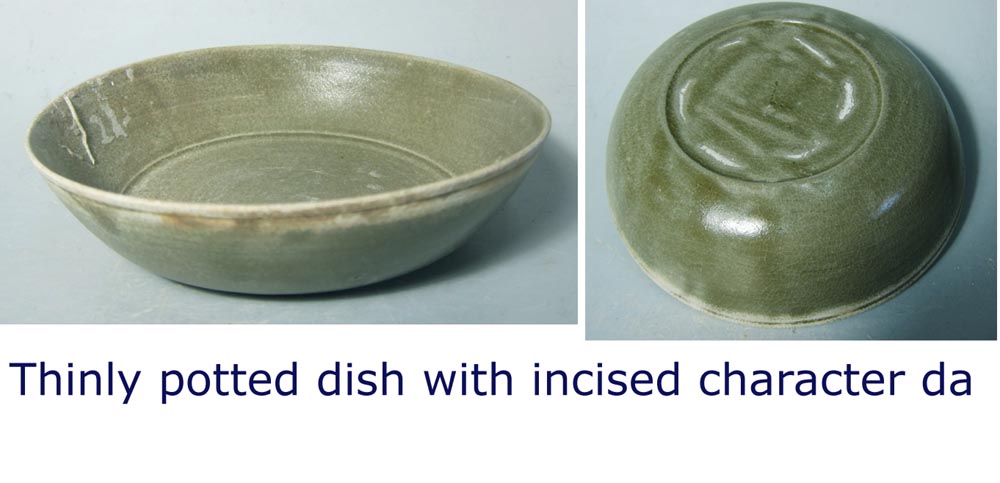
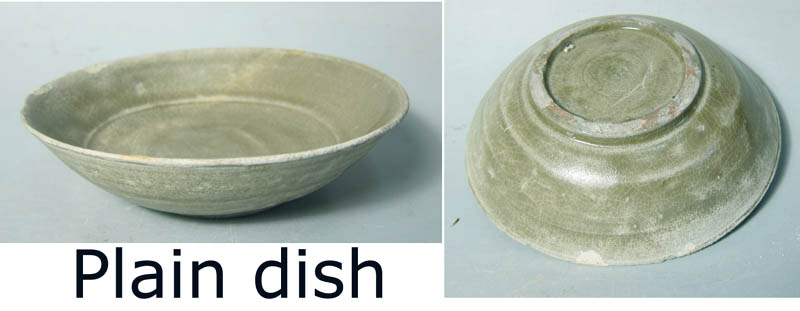
- Ewers
Ewers, another prominent category, varied in size. Most were undecorated, though luxurious versions were adorned with finely incised or carved high-relief motifs, likely intended for elite patrons.

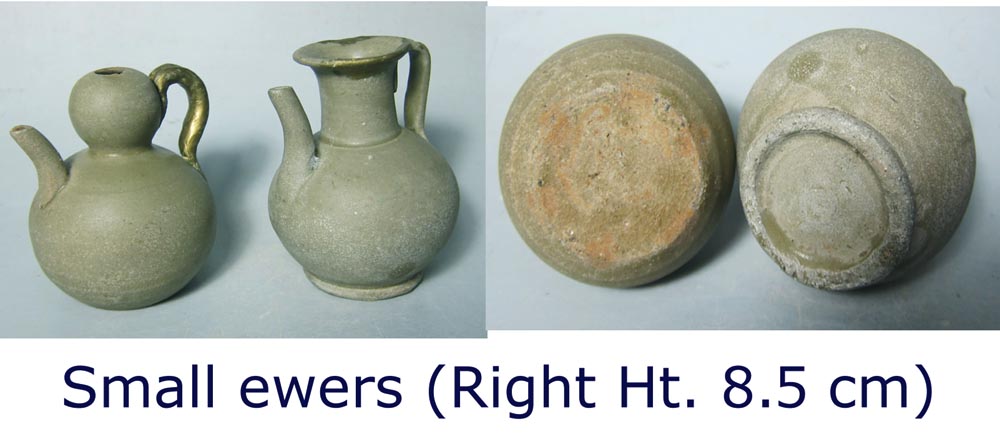
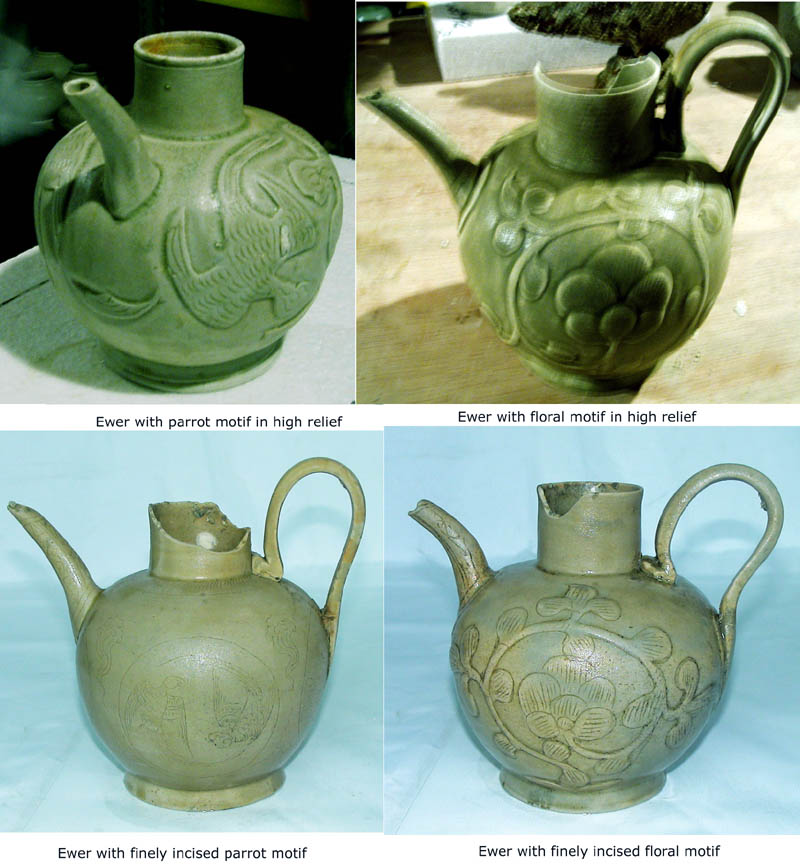
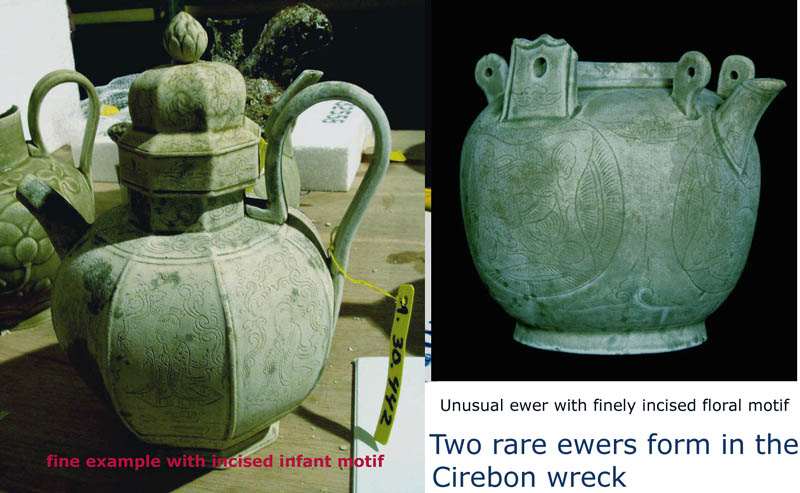

- Pots
Pots constituted a significant portion of the cargo. While many are plain or fluted, numerous examples feature the iconic carved lotus petal motif. Rare specimens display delicate incised decoration.

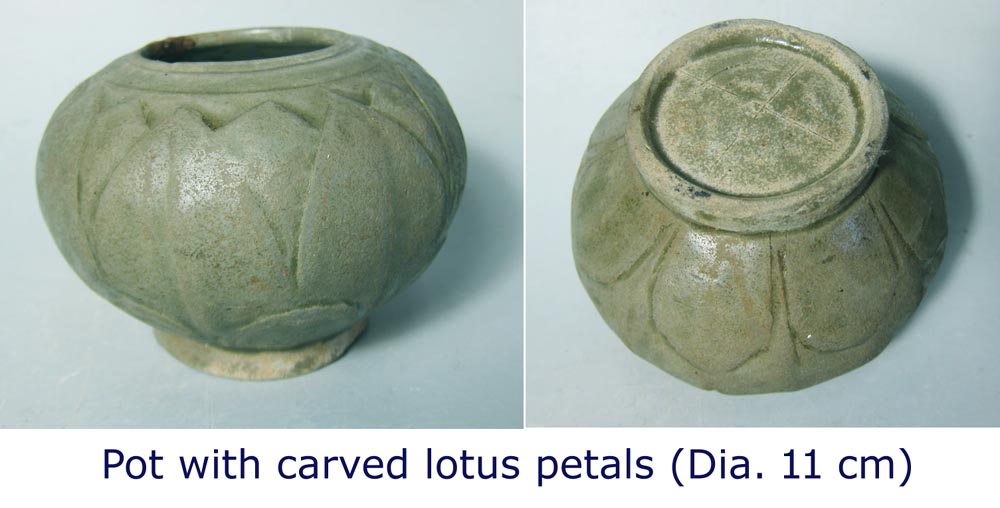
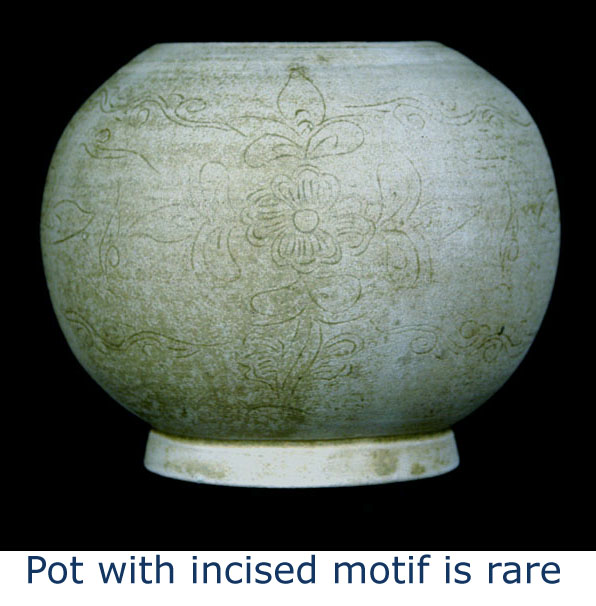
A distinct subgroup of pots exhibits a lighter green
glaze paired with bold, coarser lotus carvings. Though
likely produced at Wenzhou kilns in Zhejiang, these are
classified as “Yue-type” wares due to their stylistic
affinity with Yue traditions.
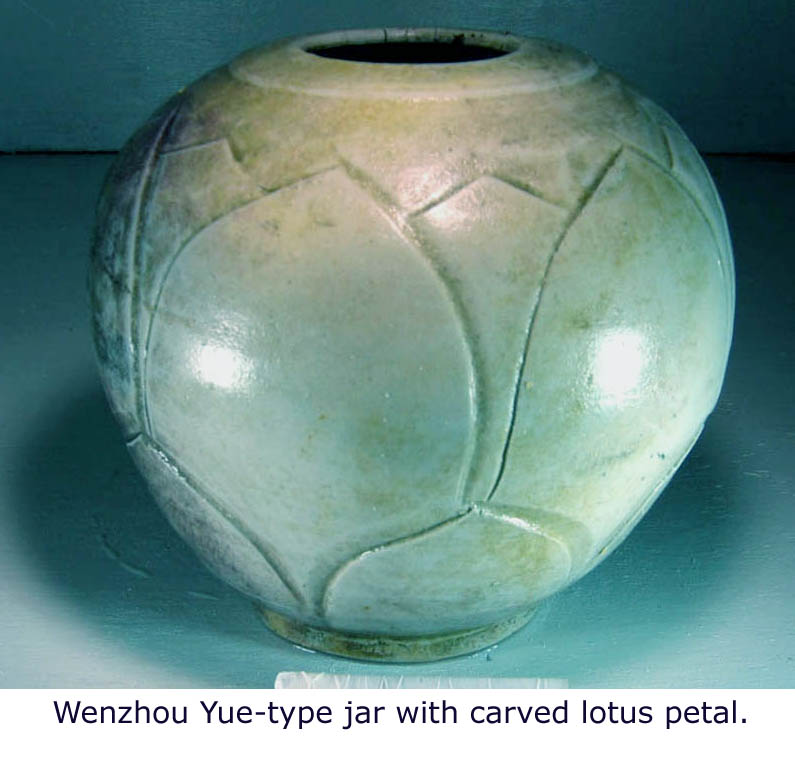
- Other Notable Forms
The cargo also included a small number of covered boxes,
cups, and rare objects such as a *makara*-shaped oil
lamp (a mythical aquatic creature), a multi-tiered food
tray, a cup stand, a bird whistle, and a conch.
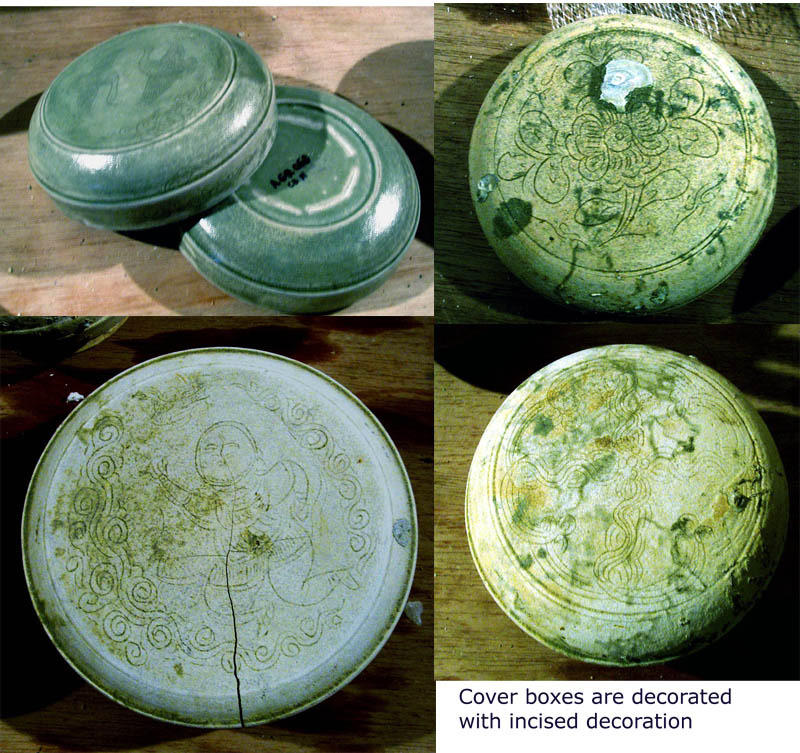
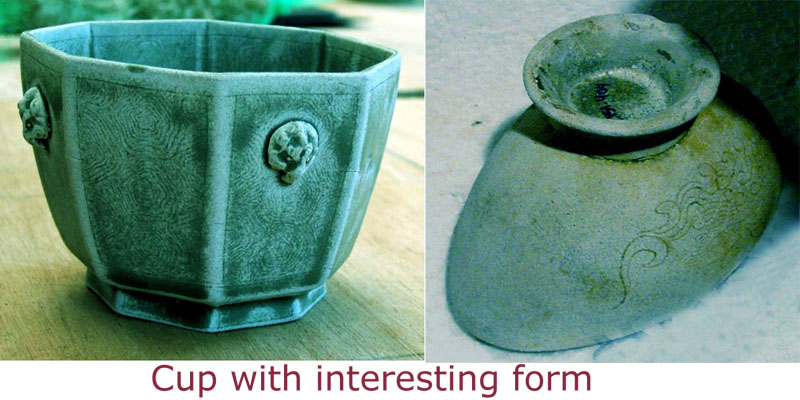
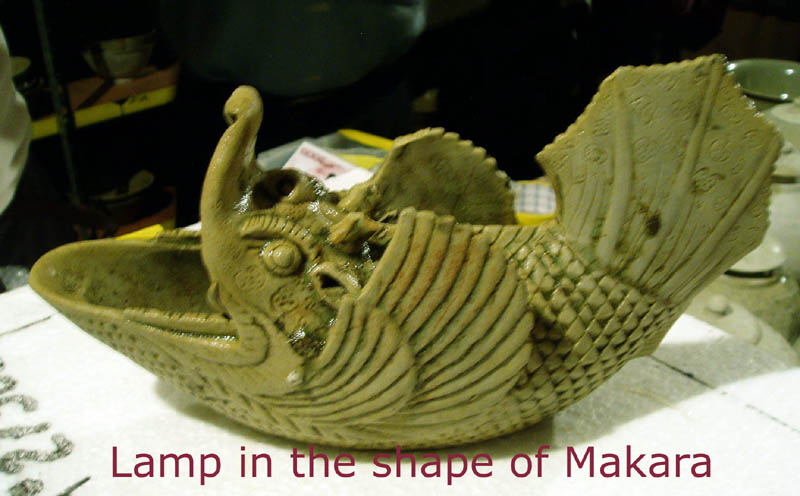
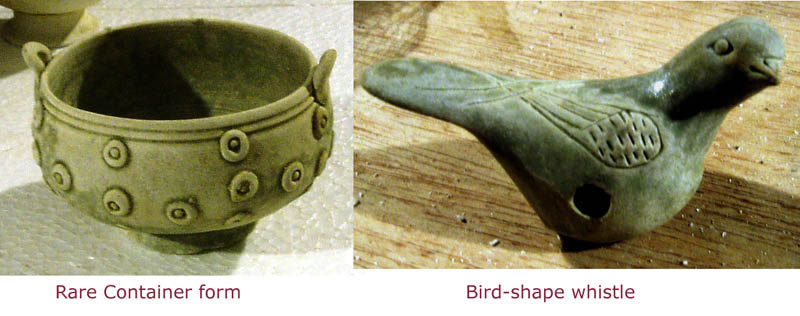

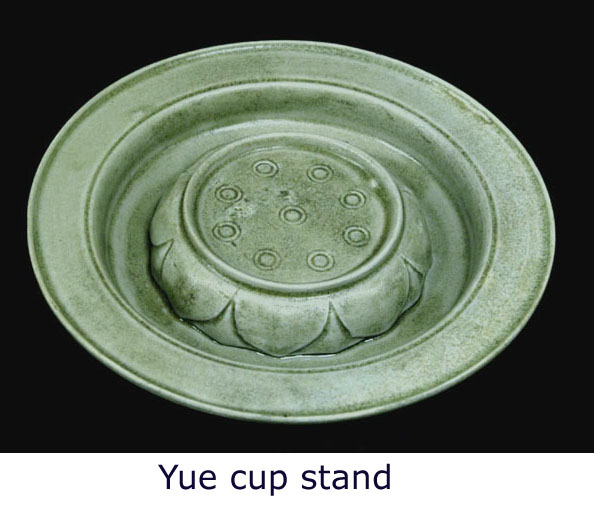
Decorative Techniques
Yue artisans employed diverse decorative methods, including carving, incising, sgraffito, appliqué, molding, and openwork. Fine incising flourished from the Five Dynasties through the early Northern Song period, featuring motifs such as phoenixes, dragons, parrots, birds, cicadas, florals, and occasional human figures.
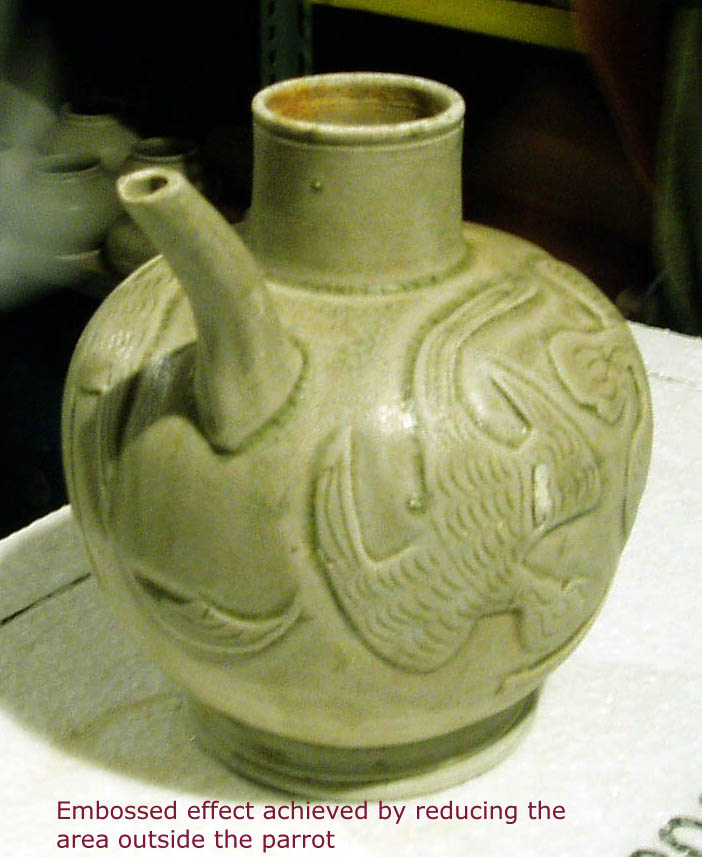 |
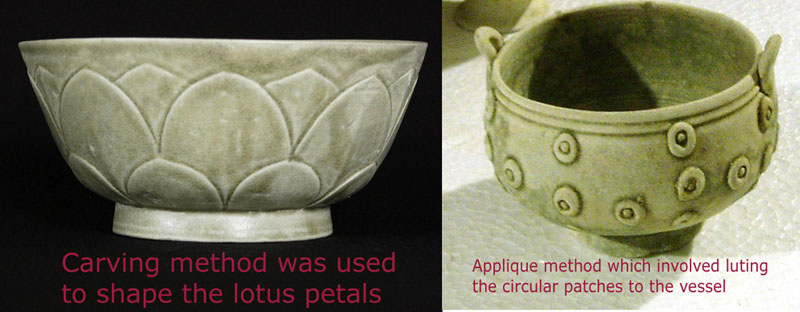 |
 |
| Mouding method was used to shape the form of phoenix head, counch, makara, deer, bird and etc. |

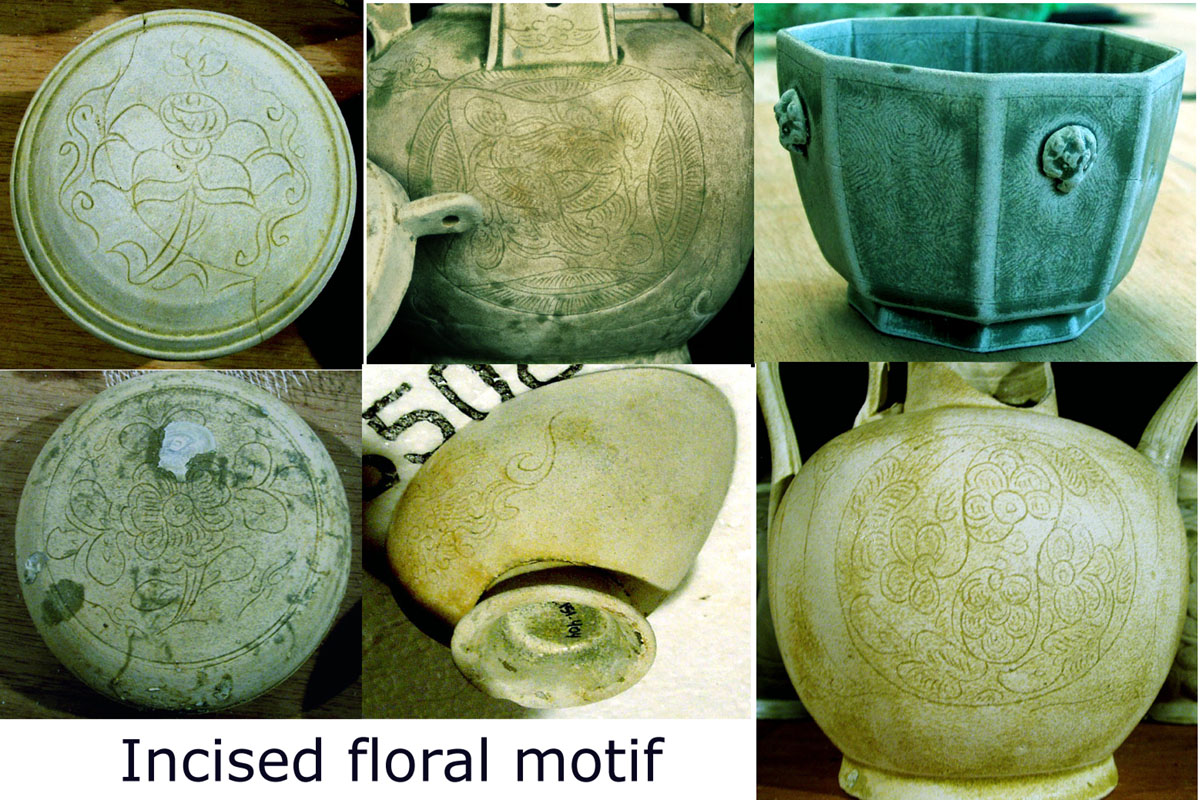
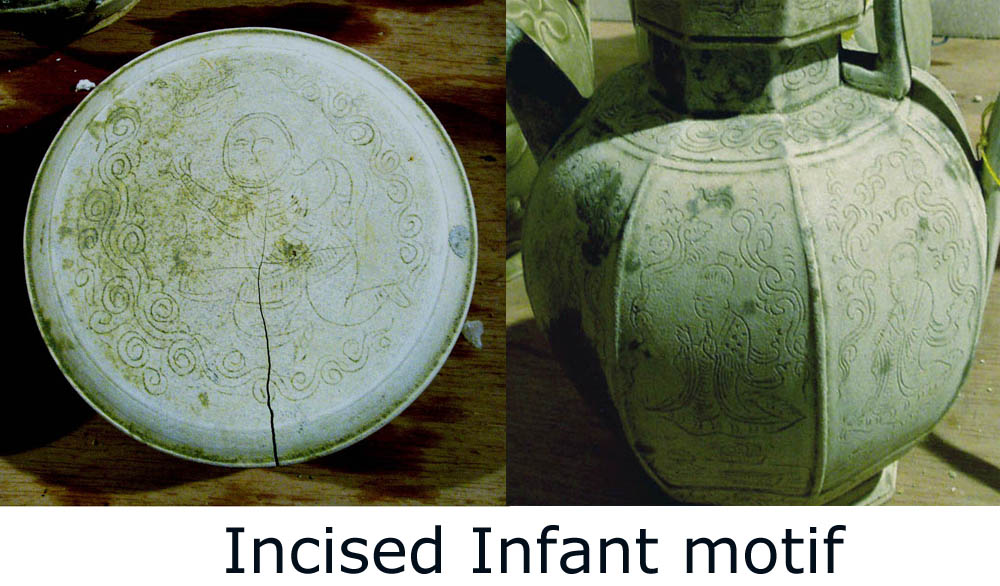
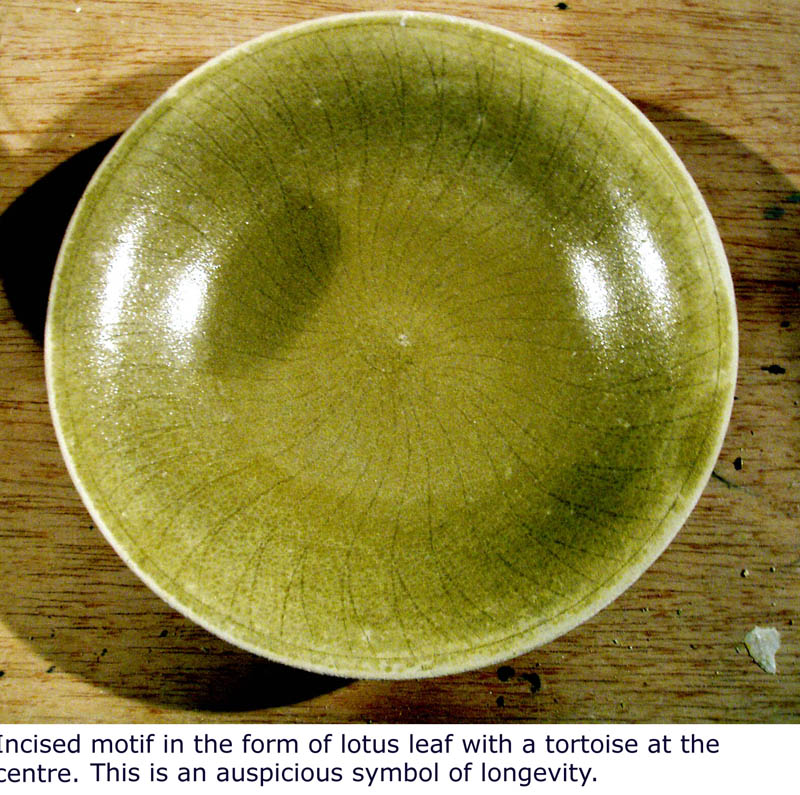
 |
| The cicada motif is sometimes mistaken for a moth or butterfly due to physical similarities. However, the cicada holds deep auspicious symbolism in Chinese decoration, representing transformation and resurrection. Its life cycle, involving years underground before emerging, reinforces this symbolism. In ancient Chinese rituals, jade cicadas were placed in the mouths of the deceased to signify permanence, purity, and transformation. Cicadas were also depicted in other materials like silver and inkstones, such as those found in the Belitung wreck. Given its cultural and religious significance, the cicada interpretation is the most appropriate. |
Inscriptions
Inscriptions on Yue wares are relatively common. Lin
Shimin (林士民), a leading scholar of Yue ceramics,
categorizes inscriptions from Wu Yue-period kiln sites
into 11 groups:
-
Surnames: 章, 王, 徐, 上, 大, 姜, 千, 合
-
Workshops: 项记, 阮记, 柴记
-
Chinese numerals: 一 (1) to 八 (8)
-
Locations: 上 (upper), 下 (lower), 右 (right), 左 (left)
-
Cyclical dates: 太平丁丑, 辛酉, 辛, 乙, 子, 丁
A bowl recovered from the wreck bears both a workshop mark and a cyclical date (*徐记烧戊辰*) incised on its base. The most frequent inscriptions—neatly executed characters such as 大 (*dà*, “large”) or 上 (*shàng*, “upper”)—appear on high-quality vessels. Lin posits these may denote kiln locations, with 上 potentially referencing an “upper” kiln location.
Rarer examples include a bowl inscribed with 天下太平
(*tiānxià tàipíng*, “peace under heaven”) on its
interior wall and another with crudely incised 大
characters on its base, both of relatively modest
quality.
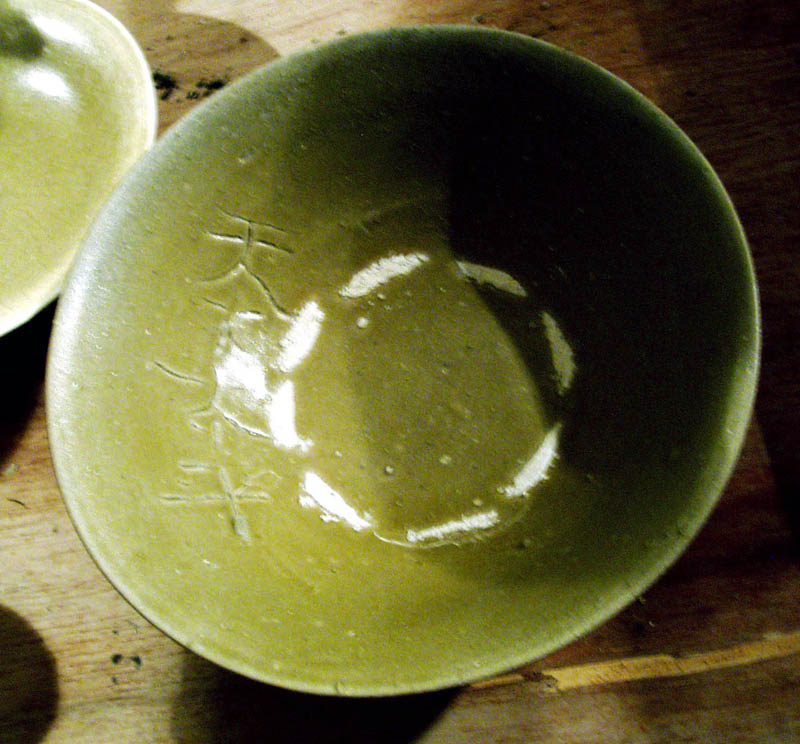 |
| Bowl with 天下太平 inscription |
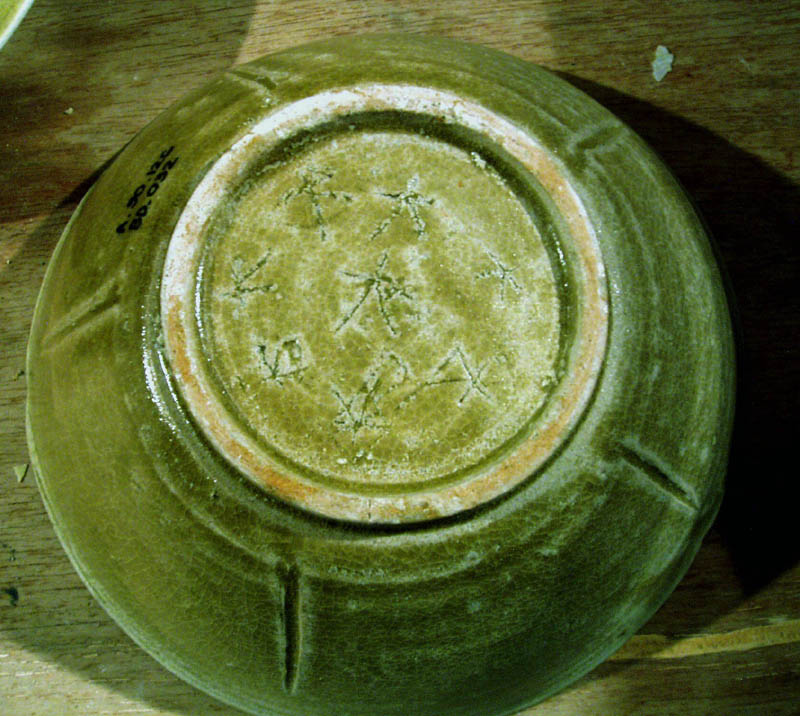 |
| Bowl with many 大 character inscription |
2. Ding White Ware
The wreck contains a significant quantity of white wares, generally identified as originating from the Ding kiln. The majority consists of bowls, while the rest includes vases, jars, ewers, covered boxes, and other items.
The wreck contains a significant quantity of white wares, generally identified as originating from the Ding kiln. The majority consists of bowls, while the rest includes vases, jars, ewers, covered boxes, and other items.
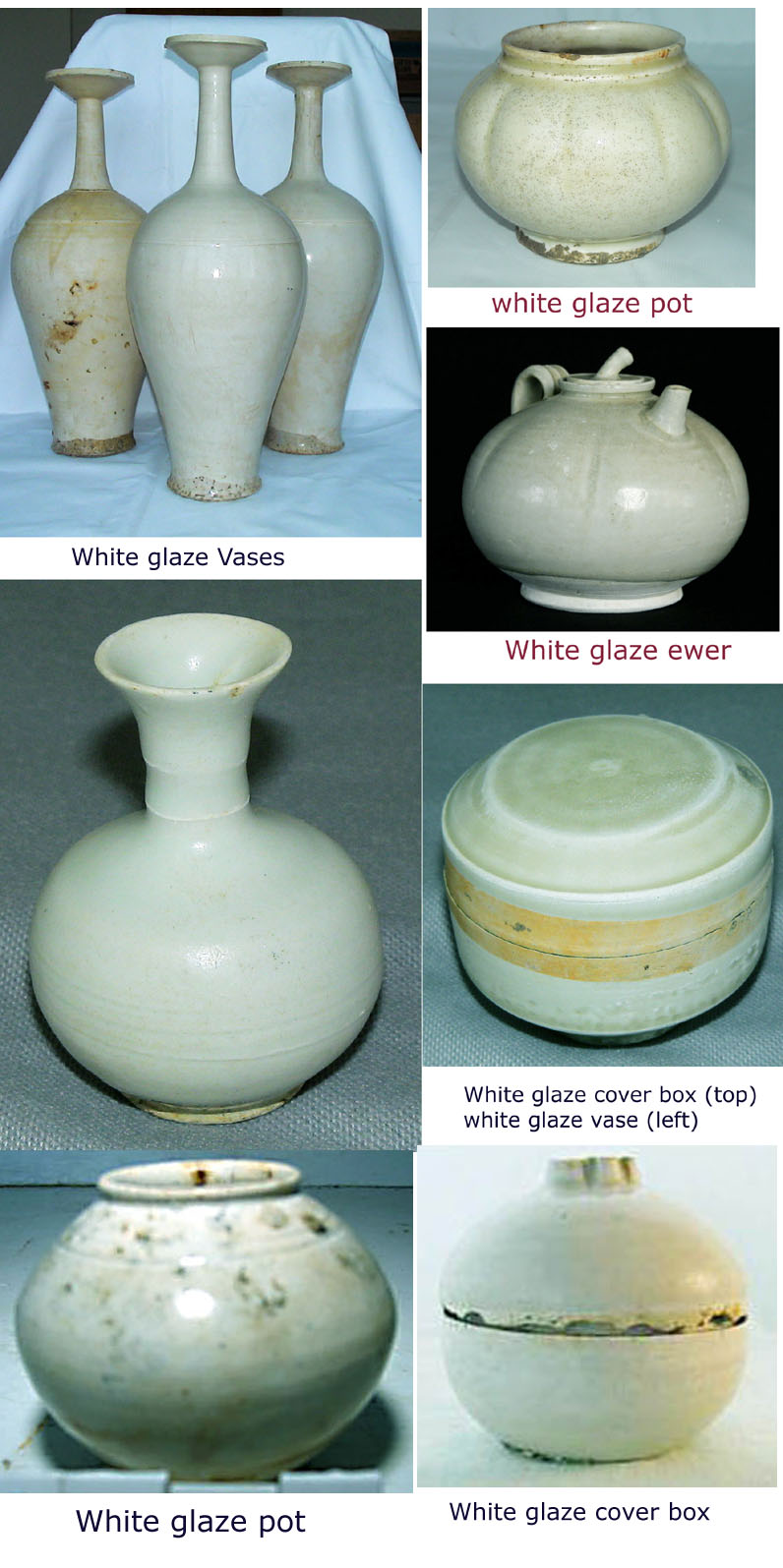
 |
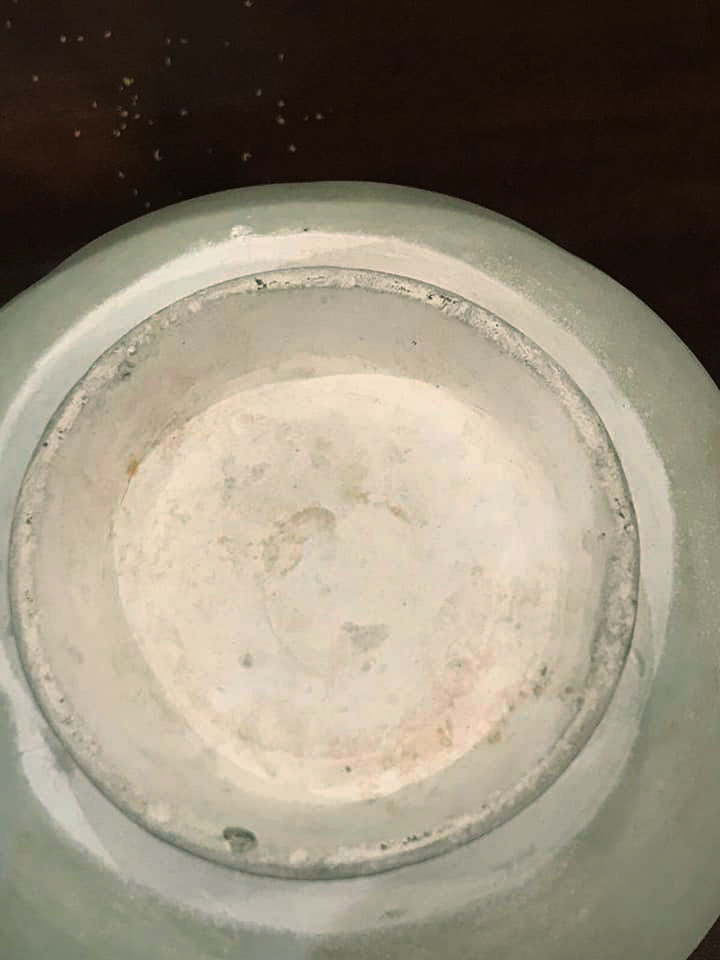 |
| Ding white glaze pot from the Intan wreck. This wreck carried similar cargo to the Cirebon wreck. | |
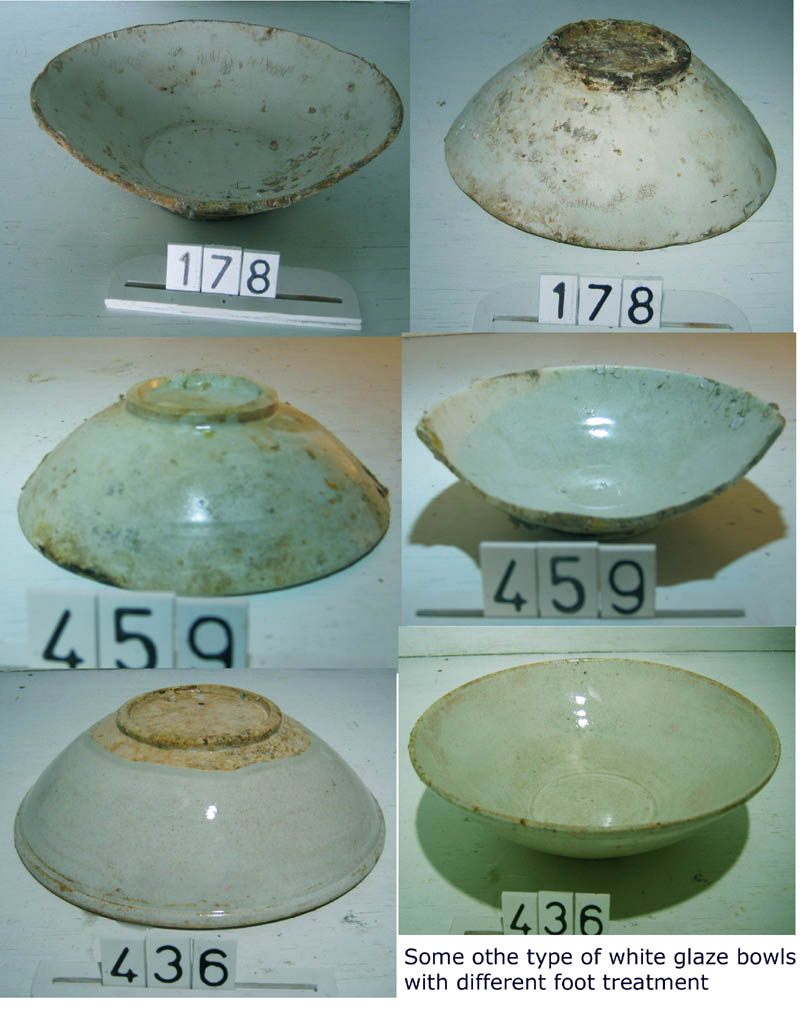
However, within Chinese academic circles, some scholars
have suggested that a substantial portion of the bowls
and dishes may have been produced at the Xuanzhou kiln
in Anhui. In 1996, archaeologists Zhang Yong (张勇) and Li
Guangning (李广宁) from Anhui attended the Annual Ancient
Ceramics Society Conference in Jianyang, Fujian. They
brought white ceramic shards excavated from the Yangong
kiln (晏公窑) in Jingxian, Anhui, sparking renewed interest
in the study of Xuanzhou white ware.
Since then, however, research progress has been limited. Few, if any, white wares have been discovered at the kiln sites, leaving insufficient information for meaningful comparisons.
Since then, however, research progress has been limited. Few, if any, white wares have been discovered at the kiln sites, leaving insufficient information for meaningful comparisons.
3. Guangdong Green Wares
Guangdong greenwares represented by large jars and
basins, were also prevalent. These were likely produced
in kilns in the Pearl River Delta, continuing a
tradition of large storage vessel production dating back
to the Tang Dynasty.
Conclusion
The Cirebon wreck provides an invaluable snapshot of
10th-century maritime trade, illustrating the economic
and cultural exchanges between China, Southeast Asia,
and the broader Indian Ocean world. The predominance of
Yue greenware underscores the dominance of Zhejiang’s
kilns in international trade, while the presence of
white wares and Guangdong greenware highlights a
diversified market. The study of these ceramics,
inscriptions, and historical contexts confirms that the
ship was likely engaged in trade between
Srivijaya-controlled ports and East Java during a
dynamic period of shifting political and economic
landscapes.
Beyond its material wealth, the wreck reveals the
intricate trade networks that connected diverse regions.
Further research will continue to refine our
understanding of the economic and artistic evolution of
Chinese ceramics and their influence on global trade
during this pivotal era.
Written by: NK Koh (28 Jan 2017), updated 21 Feb 2025
Reference: 青瓷与越窑 – 林士民